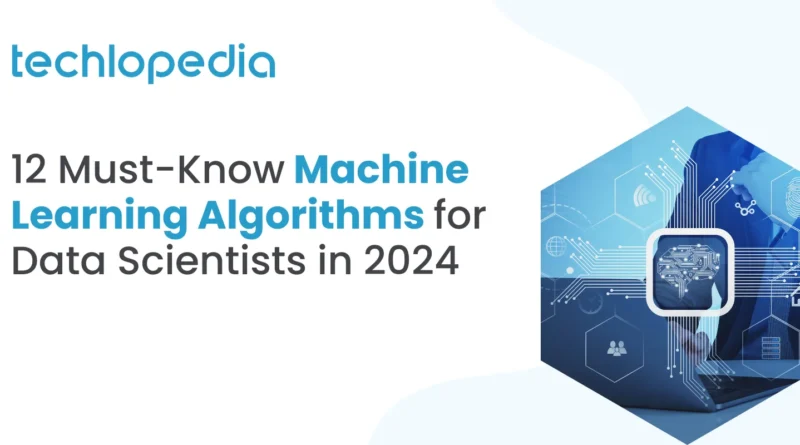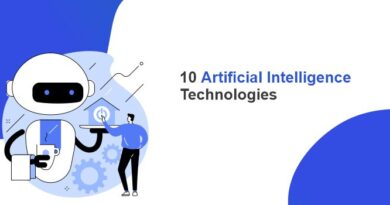12 Must-Know Machine Learning Algorithms for Data Scientists in 2024
Machine learning (ML) algorithms are the foundation of the world’s most widely used apps. From Google Search to ChatGPT and Siri, these algorithms power the services millions rely on daily. To guide you, Techlopedia has put together a list of the top machine learning algorithms that every AI enthusiast should know.
1. Linear Regression
Linear regression is a foundational algorithm in machine learning that models the relationship between a dependent variable and one or more independent variables by fitting a linear equation to the observed data. The model assumes that the change in the dependent variable is directly proportional to the change in the independent variables.
It’s particularly effective in predictive analysis, where it can forecast trends and outcomes. Common applications include predicting stock market prices, sales forecasting, and assessing the impact of marketing efforts on revenue. The simplicity and interpretability of linear regression make it a popular choice for understanding and predicting linear relationships between variables.
2. Logistic Regression
Logistic regression is used for binary classification problems where the outcome is categorical, typically 0 or 1. Unlike linear regression, which predicts continuous values, logistic regression estimates the probability that a given input point belongs to a specific class. The algorithm applies the logistic function (sigmoid) to transform the output into a probability between 0 and 1.
It’s widely used in scenarios where the goal is to predict the presence or absence of a characteristic, such as fraud detection, credit scoring, and medical diagnosis. Logistic regression’s ability to provide probabilities makes it valuable for classification tasks where a binary outcome is required.
People Also Read: Mastering Google Gemini AI: Top Tips and Best Practices
3. Decision Tree
A decision tree is a supervised learning algorithm that splits the data into subsets based on the value of input features, eventually leading to a decision or prediction at the leaf nodes. Each internal node of the tree represents a test on an attribute, and each branch represents the outcome of that test.
Decision trees are easy to interpret and can handle categorical and numerical data. They are commonly used in classification tasks like predicting customer behavior or diagnosing diseases. Their hierarchical nature allows them to break down complex decision-making processes into simpler, interpretable steps.
4. Support Vector Machine (SVM)
Support Vector Machine (SVM) is a powerful supervised learning algorithm used primarily for classification tasks. The algorithm finds the optimal hyperplane that best separates the data into different classes. In cases where the data is not linearly separable, SVM can use kernel functions to project the data into higher dimensions, making separating it easier.
SVM is effective in high-dimensional spaces and is widely used in applications like text classification, image recognition, and spam detection. Its robustness in handling outliers and the ability to classify non-linear data make it a versatile choice for many classification problems.
5. Random Forest
Random Forest is an ensemble learning method that constructs multiple decision trees during training and outputs the mode of the individual trees’ classes (classification) or mean prediction (regression). Each tree in the forest is trained on a different random subset of the training data, and the results are aggregated to improve accuracy and control overfitting.
Random Forest is highly effective in handling large datasets with higher dimensionality and is used in applications such as fraud detection, risk assessment, and recommendation systems. The ensemble approach of Random Forest increases the robustness and accuracy of predictions compared to individual decision trees.
Recommended for You: Learn the Best Way to Organize iPhone Apps with Techlopedia
6. K-Nearest Neighbor (KNN)
K-Nearest Neighbor (KNN) is a simple, non-parametric algorithm for classification and regression tasks. The algorithm works by finding the K nearest data points (neighbors) to a given query point and making predictions based on those neighbors’ majority class or average.
KNN is particularly useful in pattern recognition, data mining, and intrusion detection. Despite its simplicity, KNN can be quite effective in scenarios where the relationship between input features and output is complex. However, it is computationally expensive, especially with large datasets, as it requires calculating the distance between the query and all data points in the dataset.
7. K-Means
K-Means is an unsupervised learning algorithm for clustering data points into K-distinct groups based on their features. The algorithm assigns each data point to the cluster with the nearest mean, iteratively refining the clusters until the points no longer switch groups. K-Means is commonly used in market segmentation, customer segmentation, and anomaly detection.
It’s a simple yet powerful tool for discovering underlying patterns in large datasets. The algorithm’s efficiency and ease of implementation make it a popular choice for exploratory data analysis. However, it can be sensitive to the initial placement of centroids and the choice of K.
8. Gradient Boosting
Gradient Boosting is an ensemble learning technique that builds models sequentially, each new model correcting the errors made by the previous ones. It works by minimizing a loss function and optimizing the model’s performance iteratively. Gradient Boosting is highly effective for classification and regression tasks, particularly when dealing with large and complex datasets.
Its ability to improve weak learners makes it a powerful tool for various applications, such as credit scoring, predictive analytics, and risk modeling. However, it requires careful tuning to avoid overfitting, and training can be time-consuming for very large datasets.
9. Naive Bayes
Naive Bayes is a probabilistic classifier based on Bayes’ Theorem, assuming that features are independent given the class label. Despite this ‘naive’ assumption of independence, Naive Bayes performs surprisingly well in various classification tasks, particularly with large datasets.
Due to its simplicity and efficiency, it is especially useful for text classification, spam filtering, and sentiment analysis. The algorithm calculates the probability of each class and assigns the class with the highest probability to the input. Naive Bayes is fast, requires less training data, and works well with high-dimensional datasets. It is a popular choice for real-time prediction tasks.
10. XGBoost
XGBoost is an advanced implementation of gradient boosting designed for speed and performance. It builds upon the principles of gradient boosting but includes regularization to prevent overfitting, making it one of the most efficient and effective machine learning algorithms. XGBoost is widely used in competitions and real-world applications such as text classification, sentiment analysis, and predictive modeling.
Its scalability and ability to handle sparse data make it particularly well-suited for large datasets. Despite its complexity, XGBoost has become a favorite tool among data scientists due to its superior performance in various machine-learning tasks.
11. Stochastic Gradient Descent (SGD)
Stochastic Gradient Descent (SGD) is an optimization algorithm that minimizes the cost function in machine learning models, particularly in neural networks. Unlike traditional gradient descent, which uses the entire dataset to calculate gradients, SGD updates model parameters using a randomly selected subset of data, making it faster and more efficient for large datasets.
It’s commonly used in deep learning, logistic regression, and linear classifier training models. Although it may introduce more noise into the learning process, SGD’s speed and ability to escape local minima make it a powerful tool for building scalable machine learning models.
12. Apriori
Apriori is an unsupervised learning algorithm used for mining frequent item sets and discovering associations between variables in large datasets. It is commonly used in market basket analysis to find product combinations frequently occurring together in transactions. The algorithm works by iteratively identifying frequent item sets and using these to generate association rules.
Apriori is useful for uncovering hidden patterns in data and is widely applied in recommendation systems, inventory management, and targeted marketing. However, it can be computationally expensive, especially with large datasets, requiring multiple data scans to identify frequent item sets.
Understanding and mastering these 12 machine learning algorithms is essential for any aspiring data scientist or AI enthusiast. Each algorithm serves a unique purpose, from predicting outcomes with linear regression to uncovering hidden patterns with Apriori. As AI continues to evolve and integrate into various industries, the demand for skilled professionals who can effectively apply these algorithms will only grow.



